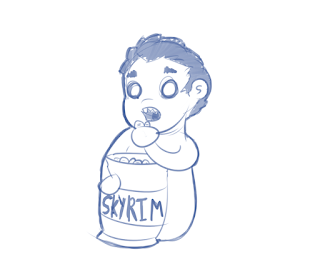The Breakdown;
Or, how to structure your story so that your middle doesn't suck the joy out of everything.
A deconstruction of novel structure, explained via the medium of animation.
I've written a lot of unpublishable novels over my life--with good reason, they sucked. But, reading back over my old work reveals a clear division between those stories confined to the trunk for eternity, and my current publishable projects.
And that's when I learnt how to structure my stories.
3 Act Structure is great and all, but while it teaches good theory, when it come to writing and thinking structure, it fell woefully short for me. My current novel, Guns of Liberty, was originally written as a study on structure and pacing. It's no coincidence that this is the first book I've had the drive to publish.
This blog is my attempt to explain structure in the simplest way I know how, and how that structure applies to story telling, and the pacing and tension of your book.
And since I'm a (regretfully unemployed) animator, I'll be using a little visual aid to explain my thought process.
End of preamble; let's get started.
What's the most important, most exciting part of your story?
Some of you probably said the ending. Some of you might have said the beginning. I'm here to argue that the middle is the most important part of your story, and here's why.
What you see above are two "Key Frames" in a very simple animation. The character is raising her hand from point A to point B. Every motion has 2 keys defining the action. All that's missing is the in-between frames.
Sure, this does the job. It gets our key frame in a simple and effective method. But, other than that there's not a lot of substance going on else wise.
Now, observe how the actions changes when I make a small tweak.
Suddenly the action tells a different story. It's no longer moving from point A to point B. There's a little arc, and with it, a little character. The action being told has changed by adding one important aspect.
Title drop. It's the Breakdown.
Between every key frame is a "Breakdown" frame. The keys define the parameters of the action, but the breakdown is what establishes the character of its motion.
And in storytelling it's exactly the same. Approximately.
Now, back to the reality of writing. The middle is often misunderstood--many writers struggle through the slog of saggy middle syndrome at some point in their lives. If the beginning and ending are your key frames, then the middle conflict is your breakdown. The objective of your story is not to get from point A to B in the straightest, most efficient way possible--rather the story is defined, and given character, by your middle conflict.
The middle of the book is what gives your story context. If the beginning tells us who your characters are, then the middle shows us who they are. It pits them against an obstacle that challenges their core beliefs, and preys on their shortcomings.
And the middle also gives your ending tension. It gives the plot stakes by showing us what can go wrong--what will go wrong if the protagonists can't pull themselves together to resolve it. It's a taste, a teaser of what's to come.
The middle is where everything that could possibly go wrong, goes wrong, and now the characters are left to pick up the pieces. The stakes are piling up. The tension mounts. Everything is on fire, and there's doubt in their minds. Can we really win after all?
Does that sound boring to you? I hope not.
If you've ever struggled with writing the middle of your book, it's because you lack this structure. Fortunately, the solution is simple. Have your protagonists arrive at their goal in the middle of the book.
This might seem crazy. After all, they're supposed to confront their goals at the end of the book, right? If they arrive in the middle, that would be the end of the book!
Nope. Because that's when everything goes wrong. That's when your characters fail so spectacularly that now everything is worse.
This can be done in a couple of ways: you can change what you thought the ending was going to be, or, change what your protagonists thought the ending was going to be.
If this is all still a little crazy sounding, let me ground you in a real-world example. Star Wars, A New Hope. It's just about the most faithful monomyth structure in modern story telling. When Luke embarks on his journey, his goal is not the end of the story. He is not setting out to destroy the Death Star, he doesn't even know what one is. All he knows is he has to get to Alderaan, and the Rebellion.
What happens when he gets there? Death Star. Now everything goes to hell, and the true end of the story is revealed.
If you look through popular media you'll see this pattern all over. This, I believe, is the simplest deconstruction of story structure.
I like to call it Shifting your Goal Posts.
Take a minute to imagine Star Wars if, instead, Luke set out from Tatooine with the goal of destroying the Death Star. He, and Han, would spend an hour of screen time flying around and getting into all sorts of space shenanigans, before finally arriving just in time to deliver the plans and save the day.
Do you see how this version loses all the stakes and tension derived from Luke's first encounter with the Death Star, and Vader?
That's why the middle is the most important part of your book. If you've ever found yourself struggling with structure, this is one way to fix it.
Question of the day: what's your main character's primary goal?












